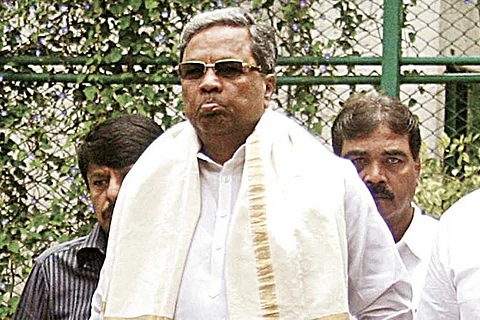

The Karnataka government’s last budget before the Assembly elections (and Siddaramaiah’s 13th budget) presented on February 16 followed the usual script of an election year budget. It was full of please-all sops and clearly aimed at wooing the electorate. However, with many of the budget announcements not being implemented in time for the polls or being perceived as inadequate, the electoral gains for the Congress party may be limited.
Firstly, the electoral utility of the Congress government’s decision to present a full-year budget when the elections are a couple of months away has raised quite a few eyebrows. The current government’s mandate ends in the middle of May 2018, which is less than two months into the financial year of 2018-19. Apart from the unconventional departure from presenting a vote-on-account in an election year, the small window available for this government may not see tangible progress on its announcements by the time the voters go to the polling booth. Many voters understand the fact that the current Congress government is not in a position to implement these announcement and may consider it as an attempt to making promises which they may not have to keep.
In an attempt to woo the farmers of the state reeling from the last year’s drought, the budget announcement of the ‘Raithu Belaku’ scheme for direct payments to dryland farmers has made news. However, the payments would most likely be made near to the Kharif sowing season which is well after the elections. Similarly, the quantum of payment of Rs 5000 per hectare is likely to be pale in the voters mind when compared to a similar direct payment system being implemented by neighbouring Telangana which provides Rs 9880 per hectare without any cap on landholding. Another announcement which has received much attention in the media is the interest free agricultural loans upto Rs 3 lakh and 3% interest on loans upto Rs 10 lakh – which is an already existing scheme and is unlikely to bring any additional electoral dividends for the Congress party.
A slew of measures announced by Siddaramaiah in his budget are aimed at satisfying the AHINDA (minorities, backward classes and Dalits) caste coalition which is key to Congress’ electoral calculus, and especially the Kuruba community to which he himself belongs. While these measures may appeal to a portion of the AHINDA vote bank, the perceived partisanship for which Siddaramaiah has faced consistent criticism is highly likely to lead to a counter-consolidation among the competing caste groups. The budget provisions may have only reinforced this persistent feeling among these castes.
Another voter group which this budget has failed to enthuse is the urban voter among whom Congress is already struggling. The devolution to urban local bodies has been reduced by a whopping 16%, from Rs 7131 crore (revised estimates) in 2017-18 to Rs 6033 crore in 2018-19.
While Siddaramaiah’s budget speech harped quite a bit on the initiatives for Bengaluru, even the announcements for the capital city seem like repackaging of routine projects which are known to suffer from implementation issues. The Rs 5000 crore package for Bengaluru announced in 2015 has shown no visible improvement in the crumbling infrastructure of the city and hence the new announcement of Rs 2500 crore has been met by disbelief. While the budget talks about the suburban railway project and Phase-III of the Metro project, the poor implementation of easily achievable initiatives like expansion of the BMTC fleet of buses (which was announced in last year’s’ budget) has cast a poor light on these announcements.
Fiscally too, Siddaramaiah may have misjudged the situation. The budget projects a fiscal deficit of 2.49% of the GSDP which is only marginally lower than what the state has averaged in the last four years (2.7%). However, a closer look at the budget data suggests that the moderate fiscal deficit in spite of the increased expenditure on account of the generous salary hike for government employees and subsidies seems to have come at the cost of capital expenditure.
The capital expenditure (excluding public debt and loans) has been reduced by Rs 1539 crore as compared to the revised estimates for 2017-18, which is a reduction of 5%. The cut in capital expenditure is consistent across sectors. Even key areas like education, health which depend on asset creation by the government have seen a reduction of almost 30% and 41% respectively. As the capital expenditure generally creates visible long-term assets which are tangible symbols of progress for the voters, it is more likely to garner votes for the incumbent government.
Meanwhile, in the run-up to the elections, the Modi government in the Centre has managed to overshadow Congress on the development narrative in the state by announcing large infrastructure projects for Karnataka. The announcement of multiple railway projects in the Union Budget quickly followed by clearance of major highway projects, including the 6-laning of the Bengaluru-Mysuru highway, has overshadowed Siddaramaiah’s budget announcements. BJP’s, and especially Prime Minister Modi’s, public statements in Karnataka have harped on these announcements.
Given these facts, Congress may find it difficult to effectively leverage the budget announcements and translate them into electoral gains. Whether Congress will be able to retain its last remaining government in a big state will now depend on how deftly it manages its caste coalitions and the campaign.
Mohitkumar Daga is a public policy consultant and is associated with the BJP. He has also worked extensively on providing public policy research for Members of Parliament across political lines. He has previously worked in rural Rajasthan on issues of local governance and development. He has an engineering degree from the University of Pune.
Views expressed are the author’s own.